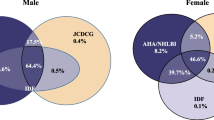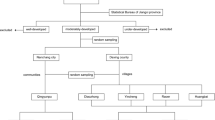Abstract
Prevalence of the metabolic syndrome (MetS) is rapidly increasing in developing countries. The aim of the study was to provide the latest nationwide estimate on the prevalence of MetS in china. Using a complex, multistage, probability sampling design, a cross-sectional study was performed in a nationally representative sample of 17,708 adults aged 45 years and older from 28 provinces in 2011–2012. MetS was defined by the “Harmonizing the Metabolic Syndrome (HMS),” the guidelines from the National Cholesterol Education Program Expert Panel on Detection, Evaluation, and Treatment of High Blood Cholesterol in Adults (modified ATP III) and the International Diabetes Federation (IDF) definition, respectively. Overall, the age-standardized prevalence of MetS defined by the modified ATP III criteria was 33.7 %, but the prevalence defined by the new HMS and IDF definition significantly increased to 43.4 and 36.2 %, respectively. And prevalence of central obesity was considerably higher (52.1 vs. 24.0 %) with the HMS (or IDF) criteria than with the modified ATP III criteria. The age-standardized prevalence of high blood pressure, hyperglycemia, hypertriglyceridemia, and low HDL cholesterol was 54.1, 57.7, 27.6, and 43.1 %, respectively. Prevalence of the metabolic syndrome was rapidly increasing in the middle-aged and older Chinese population. We may bear a higher MetS-related burden and underscore the need for strategies aimed at the prevention, detection, and treatment of MetS and special attention should be paid to elderly women population.
Similar content being viewed by others
References
Peter W, Ralph B, Helen P, Lisa S, James B. Metabolic syndrome as a precursor of cardiovascular disease and type 2 diabetes mellitus. Circulation. 2005;112:3066–72.
Salvatore M, Filion KB, Jacques G, Lawrence J, Louise P, Aul P, Stéphane R, Ernesto L, Mark J. The metabolic syndrome and cardiovascular risk: a systematic review and meta-analysis. J Am Coll Cardiol. 2010;56:1113–32.
Katherine E, Paolo C, Annamaria C, Andrea L, Dario G. Metabolic syndrome and risk of cancer: a systematic review and meta-analysis. Diabetes Care. 2012;35:2402–11.
Deedwania PC, Gupta R, Sharma KK, Achari V, Gupta B, Maheshwari A, Gupta A. High prevalence of metabolic syndrome among urban subjects in India: a multisite study. Diabetes Metab Syndr. 2014;8(3):156–61. doi:10.1016/j.dsx.2014.04.033.
Hiram B, Michael O, Meera M, Sean M. Prevalence and trends of metabolic syndrome in the adult U.S. population, 1999–2010. J Am Coll Cardiol. 2013;62:697–703.
Anoop M, Lokesh K. Obesity and the metabolic syndrome in developing countries. J Clin Endocrinol Metab. 2008;93:S9–30.
Gu D, Reynolds K, Wu X, Jing C, Xiufang D, Robert FR, Paul KW, Jiang H. Prevalence of the metabolic syndrome and overweight among adults in China. Lancet. 2005;365:1398–405.
Yao C, Hu Y, Zhai F, Yang X, Kong L. Adults prevalence of metabolic syndrome in China in 2002. Chin J Diabetes. 2007;15(6):332–9.
National Cholesterol Education Program (NCEP) Expert Panel on Detection, Evaluation and Treatment of High Blood Cholesterol in Adults (Adult Treatment Panel III). Third report of the National Cholesterol Education Program (NCEP) expert panel on detection, evaluation, and treatment of high blood Cholesterol./[Third Report of the National Cholesterol Education Program (NCEP) Expert Panel on Detection, Evaluation, and Treatment of High Blood Cholesterol in Adults (Adult Treatment Panel III) final report. Circulation. 2002;106:3143–421.
Grundy SM, Cleeman JI, Daniels SR, Donato KA, Eckel RH, Franklin BA, Gordon DJ, Krauss RM, Savage PJ, Smith Jr SC, Spertus JA, Costa F. Diagnosis and management of the metabolic syndrome: an American Heart Association/National Heart, Lung, And Blood Institute scientific statement. Circulation. 2005;112:e285–90.
Alberti KG, Zimmet P, Shaw J. The metabolic syndrome—a new worldwide definition. Lancet. 2005;366:1059–62.
Alberti K, Robert H, Scott M, Paul Z, James I, Karen A, Jean C, Pharm D, Philip W, Catherine M, Sidney C. A joint interim statement of the International Diabetes Federation Task Force on Epidemiology and Prevention; National Heart, Lung, and Blood Institute; American Heart Association; World Heart Federation; International Atherosclerosis Society; and International Association for the Study of Obesity. Joint Scientific Statement: Harmonizing the Metabolic Syndrome. Circulation. 2009;120:1640–5.
Zhao Y, Hu Y, Smith JP, Strauss J, Yang G. Cohort profile: the China Health and retirement longitudinal Study (CHARLS). Int J Epidemiol. 2014;43(1):61–8.
Zhao Y, John S, Yang G, Giles J, Hu P, Hu Y, Lei X, Liu M, Park A, James P, Wang Y. China health and retirement longitudinal study–2011-2012 national baseline users’ guide. Beijing: Peking University; 2013 http://charls.ccer.edu.cn/en/page/documentation/2011_national_baseline.
Zhao Y, Crimmins E, Hu P, Hu Y, Ge T, Kim J, Strauss J, Yang G, Yin X, Wang Y. China health and retirement longitudinal study–2011-2012 national baseline blood data users’ guide. Beijing: Peking University; 2014 http://charls.ccer.edu.cn/en/page/documentation/2011_national_baseline.
Alberti KG, Zimmet P, Shaw J. IDF epidemiology task force consensus group: the metabolic syndrome-a new worldwide definition. Lancet. 2005;366:1059–62.
National Bureau of Statistics of China. The 2010 population census of the People’s Pepublic of China. http://www.stats.gov.cn/tjsj/pcsj/rkpc/6rp/indexch.htm (in Chinese).
Jeffrey W Econometric analysis for cross section and panel data. Cambridge: MIT Press; 2002.
He Y, Jiang B, Wang J, Feng K, Chang Q, Fan L, Li X, Hu F. Prevalence of the metabolic syndrome and its relation to cardiovascular disease in an elderly Chinese population. J Am Coll Cardiol. 2006;47:1588–94.
Xi B, He D, Hu Y, Zhou D. Prevalence of metabolic syndrome and its influencing factors among the Chinese adults: The China Health and Nutrition survey in 2009. Prev Med. 2013;57:867–71.
Xi B, Liang Y, He T, Reilly KH, Hu Y, Wang Q, Yan Y, Mi J Secular trends in the prevalence of general and abdominal obesity among Chinese adults, 1993–2009. Obes Rev. 2012;13:287–96.
Xi B, Liang Y, Reilly K, Wang Q, Hu Y, Tang W. Trends in prevalence, awareness, treatment, and control of hypertension among Chinese adults 1991–2009. Int J Cardiol. 2012;158(2):326–9.
Arupenara M, Gary L. Persistent increase of prevalence of metabolic syndrome among U.S. adults: NHANES III to NHANES 1999–2006. Diabetes Care. 2011;34:216–9.
Soo L, Hayley S, Jung H, Soo H, Seon M, Ji W, Sung H, Sung I, Kyong S, Hong K, Hak C, Kwang K. Increasing prevalence of metabolic syndrome in Korea: the Korean National Health and Nutrition examination survey for 1998–2007. Diabetes Care. 2011;34:1323–8.
Liming L, Wenzhi W, Yangfeng W, Chonghua Y, Bo W, Wenzhi W. The fourth report of China National health and nutrition examination survey: hypertension 2002. Beijing, China: People’s Health; 2008(in Chinese).
Wu Y, Huxley R, Li L, Anna V, Xie G, Yao C, Woodward M, Li X, Chalmers J, Gao R, Kong L, Yang X. Prevalence, awareness, treatment, and control of hypertension in China: data from the China National Nutrition and Health survey 2002. Circulation. 2008;118:2679–86.
Xu Y, Wang L, He J, Bi Y, Li M, Wang T, Wang L, Jiang Y, Dai M, Lu J, Xu M, Li Y, Hu N, Li J, Mi S, Chen C, Li G, Mu Y, Zhao J, Kong L, Chen J, Lai S, Wang W, Zhao W, Ning G. Prevalence and control of diabetes in Chinese adults. Jama. 2013;310(9):948–58.
Weng X, Liu Y, Ma J, Wang W, Yang G, Caballero B. An urban-rural comparison of the prevalence of the metabolic syndrome in Eastern China. Public Health Nutr. 2007;10:131–6.
Jin S The tenth report of the Chinese National Health and Nutrition Examination Survey—nutrition and health status. 1st ed. Beijing: People’s Medical Publishing House; 2008.
Kim HM, Park J, Ryu SY, Kim J. The effect of menopause on the metabolic syndrome among Korean women: the Korean National Health and Nutrition Examination Survey, 2001. Diabetes Care. 2007;30(3):701–6.
Acknowledgments
The authors would also like to thank all the participants in survey design and data collection, the China Health and Retirement Longitudinal Study (CHARLS), National School of Development, and China Center for Economic Research, Peking University, Beijing, China. We thank the CHARLS leader, Professor Yaohui Zhao, and the CHARLS research and field team and every respondent in the study for their contributions.
Author information
Authors and Affiliations
Corresponding author
Ethics declarations
Funding
This study was funded by ‘Study on the Vertical Integration Strategies in Health Services for Rural Patients with Chronic Diseases Based on Comprehensive Incentive Model’ form the National Natural Science Fund of China (grant no. 71473130), ‘Current status and implementation experiences of typical collaboration models between hospitals and community health service centers’ from the general project of social science research for Jiangsu university, education department of Jiangsu province (grant no. 2014SJB161), ‘Socioeconomic inequalities in prevalence and control of diabetes mellitus in the rural Shandong, China’ (grant no. 2013NJMU029) form Nanjing Medical University.
Conflict of interest
The author declares that there is no conflict of interest.
Ethical approval
All procedures performed in studies involving human participants were in accordance with the ethical standards of the Medical Ethics Committee of Peking University and with the 1964 Helsinki Declaration and its later amendments or comparable ethical standards.
Informed consent
Informed consent was obtained from all individual participants included in the study.
Rights and permissions
About this article
Cite this article
Yang, F. Prevalence of the metabolic syndrome in the middle-aged and older Chinese population. Int J Diabetes Dev Ctries 37, 176–182 (2017). https://doi.org/10.1007/s13410-016-0472-y
Received:
Accepted:
Published:
Issue Date:
DOI: https://doi.org/10.1007/s13410-016-0472-y




